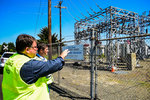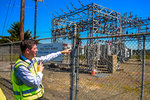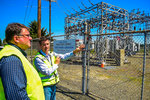


Last week, the Lewis County Public Utility District held its first of three workshops intended to start looking at the utility’s infrastructure projects over the next two decades — planning that will set the course for the district well beyond that.
“These decisions are going to last for north of 50 years,” said general manager Chris Roden. “When you’re making a choice that’s going to last half a century, you need to be fairly strategic about how you’re going to build it for today, but also for 49 years, 364 days as well.”
According to Roden, this is the first time the PUD has done this type of workshop-style strategizing about its large-scale upcoming projects. It’s looking at aging pieces of infrastructure, projections of power needs and various financial scenarios. The utility will need to plan long-term changes to its transmission system, fleet and administration.
“Overall, we have an aged electric system that’s going to require a significant amount of investment over the next 20 years, with a large number of those expenditures happening over the next 10,” Roden said. “The next big step we’ll need is to prioritize these items. We don’t have the capabilities to undertake all these projects at once.”
One of the biggest tasks facing the PUD is a “systemwide reconstruction” of its substation infrastructure. Projects to replace a substation transformer can have a lead time of two to three years, Roden said, and can cost as much as $1 million.
“We could be looking at 20 of the (PUD’s) 26 substations in the next decade that need to be replaced,” he said. “That’s two a year, and that’s a very aggressive clip just to implement it and fund it.”
Roden and engineering manager Jeff Shupe spoke Thursday at the Fords Prairie substation, which will need to be overhauled in the near future, in part due to a pending voltage conversion to meet higher demand.
“We’re all anticipating (the transition) within the next five years,” Shupe said. “We’re going to have to buy a mobile substation setup for about a million bucks. We’ll utilize it here, but we’ll be able to utilize it at the other substations as well.”
Shupe said any future upgrades will be planned to withstand seismic and severe weather events. Roden added that infrastructure will be planned with projected growth patterns in mind, leaving expansion capacity where needed — as well purchasing real estate in advance, so substations can be brought online quickly if necessary. While the upgrades will clearly be costly, Roden said they’re necessary to ensure the long-term stability of the district.
“So far, one of the clear messages (PUD commissioners) have sent me is the PUD needs to do a better job of looking forward past the current budget year,” he said.
The PUD’s investments will likely be reflected in consumers’ rates, but Roden said it’s too early to tell what those numbers will look like. The utility has two more workshops scheduled in July and August. It will also be completing its power cost and retail revenue forecasts those months, followed by a budget release in September, accompanied by public rate proceedings.
“Any investment we make comes from customer money,” Roden said. “Every dollar we spend, we want to make sure that we are obligated to spend that money or to return more than a dollar back to the customer in terms of overall cost savings.”
Many elements of the PUD’s planning, Roden noted, will actually provide near-term savings. By maintaining a better cash position, the utility expects to increase its interest income by nearly half a million dollars per year. The addition of a wholesale fueling system at the Morton operations center is expected to pay for itself in about a decade, with cost savings extending long beyond that.
The PUD is also thinking ahead when it comes to Washington state’s focus on clean energy. The utility is well-positioned to meet new state mandates in the coming years for carbon-free energy production, Roden said, as it provides more than 95 percent of customer’s needs from clean sources. The district actually produces more clean energy than it can use, selling some of it to other providers to clean up their portfolios.
“We do feel like we’re in a good position in terms of the compliance requirements, because we have been at the forefront of providing carbon-free electricity for so long,” Roden said. “We’re also very aggressive in our energy conservation efforts, helping customers keep usage low. … Those two strategies have helped us set ourselves up situationally.”
The utility does use “dispatchable” generators fueled by coal and natural gas to meet needs during times of peak demand, and it will be a challenge to replace those resources. Roden said the PUD will to look at a variety of sources in dispersed geographic locations — instead of solely relying on wind or solar in a specific area, which could experience shortfalls at certain times based on the weather.
The PUD is also planning for increased electric vehicle demand over the decades, and it’s also working to bring customers more real-time information about their consumption. More information about the PUD’s budgeting and long-term planning can be found at www.lcpud.org/budget/.